Talladega County
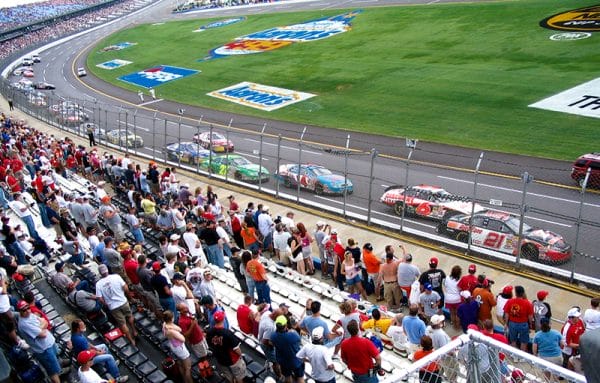 Talladega Superspeedway
Located near the geographic center of the state in the Coosa River Valley, Talladega County is home to the Talladega Superspeedway racetrack and the state’s highest mountain, Mount Cheaha. The county was also the birthplace and childhood home of actor Jim Nabors, known for his roles as Gomer Pyle on The Andy Griffith Show and Gomer Pyle USMC television series in the 1960s as well as a substantial recording career. Talladega County is governed by an elected five-member commission and includes the incorporated cities of Talladega, Sylacauga, Childersburg, and Lincoln.
Talladega Superspeedway
Located near the geographic center of the state in the Coosa River Valley, Talladega County is home to the Talladega Superspeedway racetrack and the state’s highest mountain, Mount Cheaha. The county was also the birthplace and childhood home of actor Jim Nabors, known for his roles as Gomer Pyle on The Andy Griffith Show and Gomer Pyle USMC television series in the 1960s as well as a substantial recording career. Talladega County is governed by an elected five-member commission and includes the incorporated cities of Talladega, Sylacauga, Childersburg, and Lincoln.
- Founding Date: December 18, 1832
- Area: 753 square miles
- Population: 80,244 (2020 Census estimate)
- Major Waterways: Coosa River
- Major Highways: Interstate 20, U.S. 78, U.S. 280
- County Seat: Talladega
- Largest City: Talladega
History
Talladega County was created by an act of the Alabama General Assembly on December 18, 1832, from land ceded by the Creek Indians in the March Treaty of Cusseta. The county was named after the Creek Indian village of Talatigi, which means “border town.” The earliest settlers came to Talladega County from the Carolinas, Virginia, and Tennessee. Some of the first towns were Talladega, Sylacauga, and Childersburg.
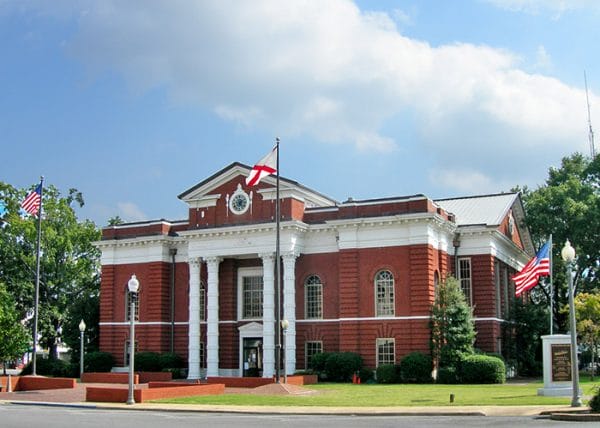 Talladega County Courthouse
The first and only county seat of Talladega County was established at Talladega City in 1834. Until the first courthouse was built in 1838, the court met in various homes and buildings. The first courthouse was a three-story structure, later reduced to two stories with a clock tower. Repairs and additions were made to the courthouse in 1882 and again in 1905. In 1908, steel magnate Andrew Carnegie’s foundation built funded the town’s first public library; it is now the Jemison-Carnegie Heritage Hall Museum. In 1912, the courthouse was struck by a tornado and then suffered fire damage in 1925. In 1977, the courthouse underwent major restoration. According to the Alabama Historical Commission, the Talladega County courthouse is the oldest courthouse in continuous use in the state of Alabama.
Talladega County Courthouse
The first and only county seat of Talladega County was established at Talladega City in 1834. Until the first courthouse was built in 1838, the court met in various homes and buildings. The first courthouse was a three-story structure, later reduced to two stories with a clock tower. Repairs and additions were made to the courthouse in 1882 and again in 1905. In 1908, steel magnate Andrew Carnegie’s foundation built funded the town’s first public library; it is now the Jemison-Carnegie Heritage Hall Museum. In 1912, the courthouse was struck by a tornado and then suffered fire damage in 1925. In 1977, the courthouse underwent major restoration. According to the Alabama Historical Commission, the Talladega County courthouse is the oldest courthouse in continuous use in the state of Alabama.
Major Cities and Demographics
 Waldo Covered Bridge
According to the 2020 Census, the population of Talladega County was 80,244. Of that total, 63.5 percent of respondents identified themselves as white, 32.3 percent African American, 2.4 percent as Hispanic, 2.2 percent as two or more races, 0.5 percent as Asian, 0.4 percent as Native American, and 0.2 percent as Hawaiian or Pacific Islander. The county seat, Talladega, is largest city in the county, with an estimated population of 15,405. Other significant population centers include Sylacauga, Childersburg, Lincoln, Oak Grove, Talladega Springs, and Munford. The median household income was $43,969, compared with $52,035 for the state as a whole, and per capita income was $24,244, compared with $28,934 for the state as a whole.
Waldo Covered Bridge
According to the 2020 Census, the population of Talladega County was 80,244. Of that total, 63.5 percent of respondents identified themselves as white, 32.3 percent African American, 2.4 percent as Hispanic, 2.2 percent as two or more races, 0.5 percent as Asian, 0.4 percent as Native American, and 0.2 percent as Hawaiian or Pacific Islander. The county seat, Talladega, is largest city in the county, with an estimated population of 15,405. Other significant population centers include Sylacauga, Childersburg, Lincoln, Oak Grove, Talladega Springs, and Munford. The median household income was $43,969, compared with $52,035 for the state as a whole, and per capita income was $24,244, compared with $28,934 for the state as a whole.
Economy
 Sylacauga Marble Quarry
Like most of Alabama, farming was the prevailing occupation of Talladega County until well into the twentieth century. A number of crops were grown in the county, but wheat was predominant. With its long stretches of upland forests, lumbering was also an important part of the economy of Talladega County. By the early twentieth century, a series of locks and dams along the Coosa River enabled the movement of goods on the river and made manufacturing a greater part of the county’s economy. Dam construction in the 1930s and 1940s brought hydroelectric power to the area, and manufacturing boomed. In 1941, the U.S. Army operated the Alabama Army Ammunition Plant, just outside Childersburg, producing chemicals such as TNT and smokeless powder. Shut down in 1945, the plant is now a Superfund toxic clean-up site. Textile manufacturing was especially important until the early twenty-first century, when Avondale Mills closed down in July 2006. Sylacauga is sometimes known as the Marble City because it sits on a solid deposit of hard, white marble. Gantt’s Quarry, near Sylacauga, is one of the largest marble quarries in the South. Today, the automotive industry is the largest industry in Talladega County.
Sylacauga Marble Quarry
Like most of Alabama, farming was the prevailing occupation of Talladega County until well into the twentieth century. A number of crops were grown in the county, but wheat was predominant. With its long stretches of upland forests, lumbering was also an important part of the economy of Talladega County. By the early twentieth century, a series of locks and dams along the Coosa River enabled the movement of goods on the river and made manufacturing a greater part of the county’s economy. Dam construction in the 1930s and 1940s brought hydroelectric power to the area, and manufacturing boomed. In 1941, the U.S. Army operated the Alabama Army Ammunition Plant, just outside Childersburg, producing chemicals such as TNT and smokeless powder. Shut down in 1945, the plant is now a Superfund toxic clean-up site. Textile manufacturing was especially important until the early twenty-first century, when Avondale Mills closed down in July 2006. Sylacauga is sometimes known as the Marble City because it sits on a solid deposit of hard, white marble. Gantt’s Quarry, near Sylacauga, is one of the largest marble quarries in the South. Today, the automotive industry is the largest industry in Talladega County.
Employment
According to 2020 Census estimates, the workforce in Talladega County was divided among the following industrial categories:
- Educational services, and health care and social assistance (21.0 percent)
- Manufacturing (19.7 percent)
- Retail trade (11.8 percent)
- Arts, entertainment, recreation, and accommodation and food services (7.9 percent)
- Transportation and warehousing, and utilities (7.2 percent)
- Construction (7.1 percent)
- Public administration (5.8 percent)
- Professional, scientific, management, and administrative and waste management services (5.5 percent)
- Other services, except public administration (4.8 percent)
- Finance and insurance, and real estate, rental, and leasing (4.3 percent)
- Wholesale trade (2.1 percent)
- Agriculture, forestry, fishing and hunting, and extractive (1.5 percent)
- Information (1.2 percent)
Education
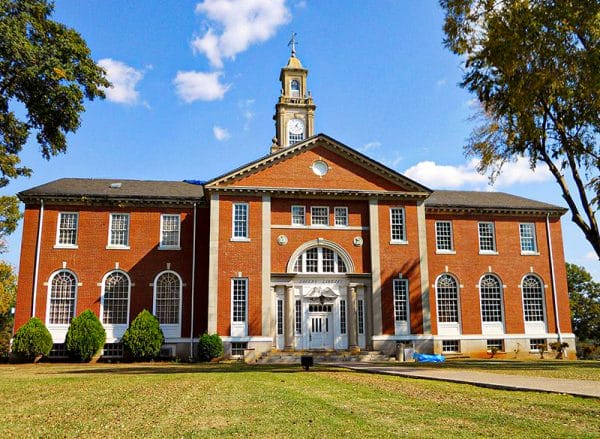 Talladega College
The Talladega County School System oversees 18 primary and secondary schools. Sylacauga City Schools oversees four primary and secondary schools and Talladega City Schools oversees nine primary and secondary schools. Talladega College in Talladega City is a historically black four-year liberal arts college offering a variety of academic degrees. Established in 1867, it is the oldest historically black college in the state of Alabama (Alabama State University also was founded in 1867). Founded in 1858, the Alabama Institute for Deaf and Blind in Talladega consists of the Alabama School for the Deaf, the Alabama School for the Blind, and the Helen Keller School. The institute also includes a series of regional and technical centers to support the development of those with sensory impairments.
Talladega College
The Talladega County School System oversees 18 primary and secondary schools. Sylacauga City Schools oversees four primary and secondary schools and Talladega City Schools oversees nine primary and secondary schools. Talladega College in Talladega City is a historically black four-year liberal arts college offering a variety of academic degrees. Established in 1867, it is the oldest historically black college in the state of Alabama (Alabama State University also was founded in 1867). Founded in 1858, the Alabama Institute for Deaf and Blind in Talladega consists of the Alabama School for the Deaf, the Alabama School for the Blind, and the Helen Keller School. The institute also includes a series of regional and technical centers to support the development of those with sensory impairments.
Geography
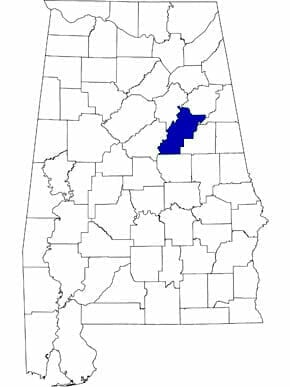 Talladega County Map
Consisting of more than 750 square miles, Talladega County lies in the Coosa River Valley at the southern end of the Appalachian mountain range. The county is divided between the Valley and Ridge physiographic section to the northeast and the Piedmont physiographic section to the southwest. Although the valleys have been cleared for farming, the uplands and the Talladega National Forest at the eastern edge of the county remain heavily wooded with oak and pine trees. Talladega County is bordered by Calhoun County to the north, Cleburne and Clay Counties to the east, Coosa County to the south, and Shelby and St. Clair Counties to the west.
Talladega County Map
Consisting of more than 750 square miles, Talladega County lies in the Coosa River Valley at the southern end of the Appalachian mountain range. The county is divided between the Valley and Ridge physiographic section to the northeast and the Piedmont physiographic section to the southwest. Although the valleys have been cleared for farming, the uplands and the Talladega National Forest at the eastern edge of the county remain heavily wooded with oak and pine trees. Talladega County is bordered by Calhoun County to the north, Cleburne and Clay Counties to the east, Coosa County to the south, and Shelby and St. Clair Counties to the west.
The Coosa River and its tributaries run throughout Talladega County. The Coosa is one of the most utilized rivers in the state, so much of the river’s diversity is restricted to its tributaries, which fan out throughout the county. A series of locks and dams along the Coosa River provide business and recreational opportunities for the county.
Interstate 20 is one of Talladega County’s main transportation routes. It runs east-west across the northern portion of the county. U.S. Highway 78 also runs east-west just north of Interstate 20. U.S. Highway 280 runs northwest-southeast near the county’s southern border. Talladega Municipal Airport in Talladega and Merkel Field Sylacauga Municipal Airport in Sylacauga are the county’s only public airports.
Events and Places of Interest
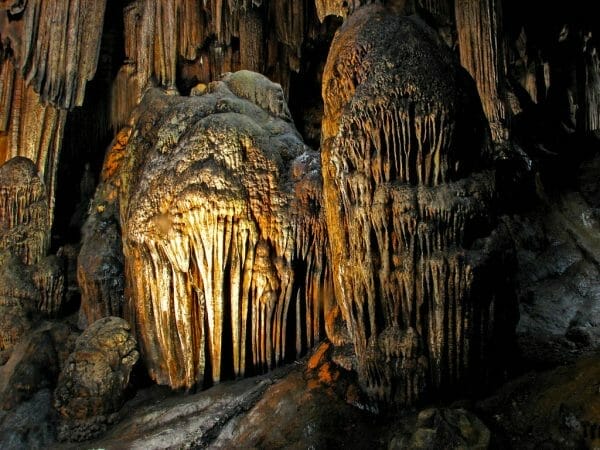 Majestic Caverns Flowstone
There are numerous recreational opportunities for visitors to Talladega County. Talladega National Forest covers 375,000 acres of upland hills and low mountains that provide habitat for a diverse array of wildlife. Visitors can enjoy a variety of outdoor activities including fishing, hunting, hiking, camping, and picnicking. Portions of the Cheaha Wilderness and Cheaha State Park also lie within Talladega County. Known for its elevated terrain and panoramic views, the park attracts hikers from all over the Southeast.
Majestic Caverns Flowstone
There are numerous recreational opportunities for visitors to Talladega County. Talladega National Forest covers 375,000 acres of upland hills and low mountains that provide habitat for a diverse array of wildlife. Visitors can enjoy a variety of outdoor activities including fishing, hunting, hiking, camping, and picnicking. Portions of the Cheaha Wilderness and Cheaha State Park also lie within Talladega County. Known for its elevated terrain and panoramic views, the park attracts hikers from all over the Southeast.
Resting at the foot of the Appalachian Mountains in Childersburg is Majestic Caverns, a privately owned cave system that offers guided tours. The park’s largest cave is 12 stories high and longer than a football field. The caverns are decorated with thousands of stalactite and stalagmite formations, making it one of the most concentrated collections of such specimens in the United States. Visitors may also enjoy a variety of activities, such as panning for gemstones or navigating the giant Lost Trail Maze.
 Kymulga Grist Mill
The Kymulga Grist Mill and Covered Bridge are located just northeast of Childersburg. Built by a Confederate soldier, the mill and bridge are more than 140 years old and are listed on the National Register of Historic Places. Several of the park’s trees are believed to be older than the mill itself. Visitors to the mill and bridge can picnic in the adjacent park with its many animals and plants. Other places in Talladega County of historic significance include the Waldo Covered Bridge (1858) near the community of Waldo, the Courthouse Square Historic District and Silk Stocking District and the Ritz Theatre in Talladega, the Sylacauga Historic District, and Swayne Hall on the Talladega College Campus. The Isabel Anderson Comer Museum and Arts Center in Sylacauga promotes local arts and humanities efforts and includes exhibits on notable local people and historical events.
Kymulga Grist Mill
The Kymulga Grist Mill and Covered Bridge are located just northeast of Childersburg. Built by a Confederate soldier, the mill and bridge are more than 140 years old and are listed on the National Register of Historic Places. Several of the park’s trees are believed to be older than the mill itself. Visitors to the mill and bridge can picnic in the adjacent park with its many animals and plants. Other places in Talladega County of historic significance include the Waldo Covered Bridge (1858) near the community of Waldo, the Courthouse Square Historic District and Silk Stocking District and the Ritz Theatre in Talladega, the Sylacauga Historic District, and Swayne Hall on the Talladega College Campus. The Isabel Anderson Comer Museum and Arts Center in Sylacauga promotes local arts and humanities efforts and includes exhibits on notable local people and historical events.
Perhaps the most popular modern attraction in the county is the Talladega Superspeedway, one of the biggest, fastest, and most competitive motorsports facilities in the world. Inaugurated in 1969, the speedway can seat more than 143,000 spectators in the grandstands and thousands more in the 212-acre infield. Adjacent to the track is the International Motorsports Hall of Fame and Museum, which honors the most accomplished men and women in motorsports.
Further Reading
- The Heritage of Talladega County, Alabama. Clanton, Ala.: Heritage Publishing Consultants, 2000.
- Jemison, E. Grace. Historic Tales of Talladega. Huntsville, Ala.: Strode Publishers, 1984.
External Links
- Talladega County
- Talladega County Schools
- City of Talladega
- City of Childersburg
- City of Lincoln
- Town of Munford
- Town of Oak Grove
- City of Sylacauga
- Greater Talladega/Lincoln Area Chamber of Commerce
- National Register of Historic Places: Talladega County
- Talladega College
- Alabama Institute for the Deaf and Blind
- Talladega Superspeedway
- International Motorsports Hall of Fame and Museum
- Jemison-Carnegie Heritage Hall Museum
- Cheaha State Park
- Majestic Caverns
- Kymulga Grist Mill and Park
- Ritz Theatre



